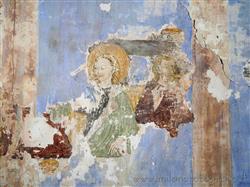|
Carpignano Sesia (Novara, Italy): Church of Santa Maria di Lebbia
|
|
|
Show an other place around Milan worth a visit: |
 The Church of Santa Maria di Lebbia, built between the fourteenth and fifteenth centuries, was originally the parish church of the village, as evidenced by the fact that it is still called also Church of Santa Maria Maggiore today. Originally it was also wider, with the presence of two naves, divided by masonry pillars. It was only in 1681 that the second nave, located on the left side of the current church, was eliminated during a radical restoration due to the precarious conditions of the building. The remaining nave was not modified and the pointed arches visible today are still the original ones. The Church of Santa Maria di Lebbia, built between the fourteenth and fifteenth centuries, was originally the parish church of the village, as evidenced by the fact that it is still called also Church of Santa Maria Maggiore today. Originally it was also wider, with the presence of two naves, divided by masonry pillars. It was only in 1681 that the second nave, located on the left side of the current church, was eliminated during a radical restoration due to the precarious conditions of the building. The remaining nave was not modified and the pointed arches visible today are still the original ones.
The current church is characterized by an elongated and low shape, with walls of river pebbles supplemented by bricks. The façade is gabled and is devoid of any decoration. At the rear there is a large semicircular apse, as wide and high as the nave.
The windows are arranged asymmetrically: on the facade a larger one above the entrance and a smaller one on the right, in the body of the church one on the right side of the nave and another on the right side of the apse.
The roof is exposed, supported by large wooden beams.
Internally the apse is covered by a vault with five segments and is separated from the nave by a masonry balustrade. The altar is in masonry and decorated with stuccoes in the late Renaissance style but made in 1680. The frescoes on the balustrade depicting false columns were made by Alessandro Grassi from Borgosesia in 1761. The decorations of the walls and of the apse vault depicting stucco decorations in neo-Gothic style date back to the end of the nineteenth century.
At various points, however, the original frescoes, much older, emerge. On the right wall you can recognize a Romanesque Saint Peter (repainted by Alessandro Grassi from Borgosesia in 1761), and, at the side entrance, a ruined fresco in several places depicting Saint Francis of Assisi receiving the stigmata. The Saint is portrayed on his knees with his arms open and slightly raised, with his gaze turned towards Christ, who appeared in the form of a cherub; further down you can see the figure of a friar witnessing the event, with his hands raised to protect his eyes from the splendor of the apparition. Behind the figure of the Saint is the small church of the Porziuncola. It is thought that this fresco dates back to a period prior to the end of the fifteenth century.
On the right wall of the apse we can see some parts of a Communion of the Apostles (large photo), painted in the style of the end of the fifteenth century.
Categories: Places of historical value of artistic value
45.551387, 8.415569 |
Further pictures of Church of Santa Maria di Lebbia in the section Photography |